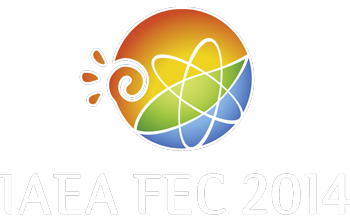Speaker
Dr
daniele carnevale
(Universita' Roma Tor Vergata, Dipartimento di Ing. Civile ed Ing. Informatica)
Description
Runaway electrons (RE) are highly energetic electrons that might gain energy up to 20-30MeV (FTU). Runway electron beam can be harmful for plasma facing components: its low pitch angle allows the deposition of a high amount of energy on small areas yielding serious and deep damages of the vessel structure. For Tokamakas such as ITER, RE beams current should be around 11-13 MA and an impact with the vessel would irreparably damage the machine.
We have proposed a new tool in the FTU plasma control system (PCS) for position and Ip ramp-down control of disruption-generated runaway electrons and first experimental results are discussed.
The RE hybrid control algorithm switches among three phases: 1) in the Ip pre-quench phase the currents in the poloidal coils used for the radial control of the plasma are optimized by a dedicated algorithm called Current Allocator; 2) when the Ip quench is detected (on-line) the system performs actions to improve the radial control in case of formation of a RE plateau; 3) at the onset of the RE plateau, which is detected on-line by dedicated algorithms, the Ip is ramped down and the RE beam position is controlled, by means of real-time (RT) diagnostic signals (magnetics, neutrons), in such a way to minimize the interactions with the plasma facing components and safely shut down the discharge.
This algorithm was tested in dedicated low density plasma discharges in which a significant RE population is generated during the Ip flat top and Ne gas is injected to induce a disruption: the rapid variation of the resistivity and the increased loop voltage at the disruption accelerate the pre-existing RE population and lead, in some cases, to the formation of a RE current plateau. The effectiveness of the RE hybrid control algorithm in this phase will be discussed as well as the possible improvements including code portability to other devices.
| Country or International Organisation | Italy |
|---|---|
| Paper Number | EX/P2-48 |
Author
Dr
daniele carnevale
(Universita' Roma Tor Vergata, Dipartimento di Ing. Civile ed Ing. Informatica)
Co-authors
Mr
Basilio Esposito
(ENEA)
Dr
Edmondo Gionannozzi
(ENEA)
Dr
GUSTAVO GRANUCCI
(ISTITUTO DI FISICA DEL PLASMA - CNR)
Dr
Gianluca Pucella
(ENEA)
Mr
Luca Boncagni
(ENEA)
Dr
Sergio Galeani
(Università di Roma Tor Vergata)
Dr
cesidio cianfarani
(enea)
Dr
daniele marocco
(enea)
Dr
francesco belli
(enea)
Dr
giorgio maddaluno
(enea)
Dr
marco riva
(enea)
Mr
mario sassano
(Università di Roma Tor Vergata)
Dr
onofrio tudisco
(enea)
Dr
salvatore podda
(enea)
Dr
vincenzo vitale
(enea)

